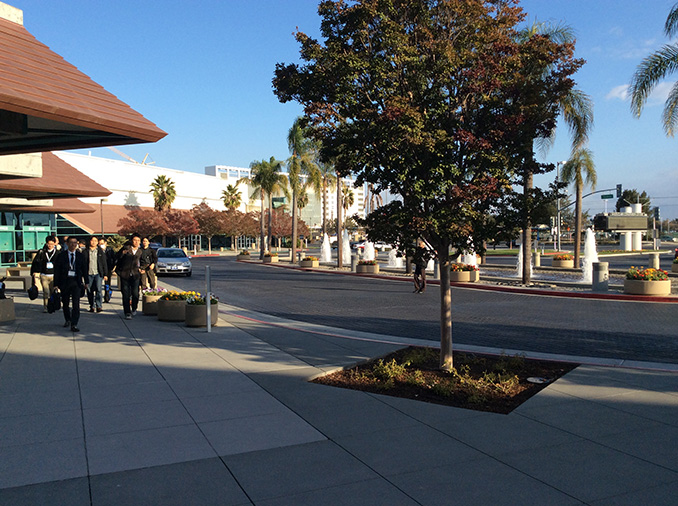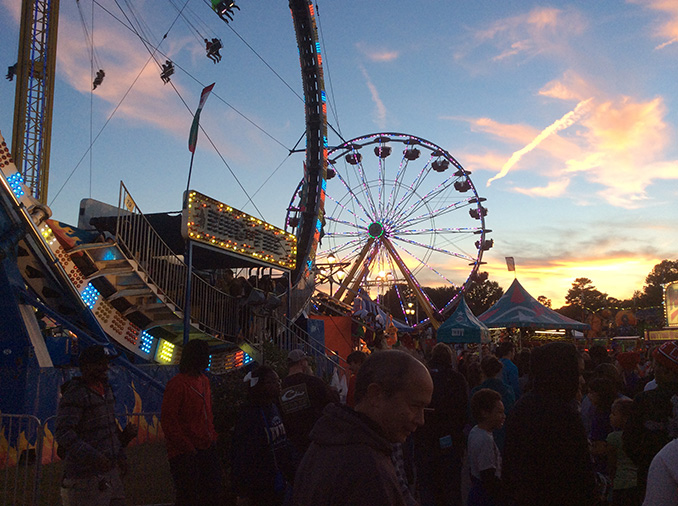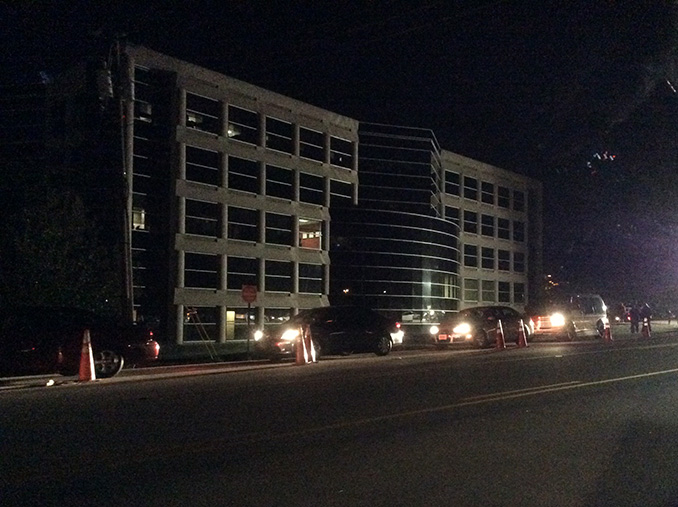The iPad Air Review
by Anand Lal Shimpi on October 29, 2013 9:00 PM ESTCamera
Front and rear facing cameras are necessary features on all modern, premium tablets. The usage model for a rear facing camera on a tablet is hopefully not as a primary image capture device but rather a convenient one. The idea being that if you’re on location somewhere using the iPad for work or play and need to quickly grab an image, having a decent rear facing camera can come in handy rather than having to put away your tablet, pull out your phone and then switch back afterwards.
Apple has improved its iPad imaging systems almost every single generation. That being said, the iPad Air is a bit of an exception to the rule as it retains the same rear camera sensor as the 4th generation iPad. We’re still talking about a 5MP sensor with f/2.4 lens, although the iPad Air now has a wider field of view with a 3.3mm focal length (identical to the original iPad mini).
| Rear Facing Camera Comparison | |||||||
| Sensor | Resolution | Aperture | Focal Length | ||||
| Apple iPad Air | 5MP | 2592 x 1936 | f/2.4 | 3.3mm | |||
| Apple iPad 4 | 5MP | 2592 x 1936 | f/2.4 | 4.3mm | |||
| Apple iPad 3 | 5MP | 2592 x 1936 | f/2.4 | 4.3mm | |||
| Apple iPad 2,4 | 0.7MP | 960 x 720 | f/2.4 | 2.0mm | |||
| Apple iPad mini | 5MP | 2592 x 1936 | f/2.4 | 3.3mm | |||
The rear facing camera tends to shoot at lower ISOs than the rear camera on the iPad 4. Since there’s no substantial change in the sensor or lens system however, the result is less noise but a darker image in low light situations. I suspect this might be more of a configuration default for the software layer driving the H6 ISP in Apple’s A7. Image quality is surprisingly good:
Even lower light shots come out fairly well:
Although obviously noise goes up appreciably once you get into really dark scenes:
I took a bunch of photos at the NC State Fair as well as on my trip out to Santa Clara following the iPad launch event in the gallery below.
Despite using the same ISP as the iPhone 5s, there’s no 10 fps burst capture mode on the iPad Air. Similarly there’s no slo-mo video recording mode either. The iPad Air does inherit the other benefits of the new H6 ISP however. Image capture is still insanely quick, which makes me wonder if the A7’s ISP also leverages that large on-die system cache.
| Front Facing Camera Comparison | |||||||
| Sensor | Resolution | Aperture | Focal Length | ||||
| Apple iPad Air | 1.2MP | 1280 x 960 | f/2.4 | 2.15mm | |||
| Apple iPad 4 | 1.2MP | 1280 x 960 | f/2.4 | 2.18mm | |||
| Apple iPad 3 | 0.3MP | 640 x 480 | f/2.4 | 1.8mm | |||
| Apple iPad 2,4 | 0.3MP | 640 x 480 | f/2.4 | 1.8mm | |||
| Apple iPad mini | 1.2MP | 1280 x 960 | f/2.4 | 2.2mm | |||
The front facing camera does see an improvement in sensitivity thanks to a larger sensor format. My understanding is this is the same sensor/lens combination as what’s in the iPhone 5s and 5c. Similarly to its implementation in the 5s, Apple seems to use the new front facing camera system to drive to lower ISOs and/or higher shutter speeds. You typically end up with a lower noise/sharper image, although sometimes there is a brightness/exposure tradeoff.
The other feature leveraged by the new front facing camera is the inclusion of a second microphone for noise cancellation. The goal here is to use the second mic to cancel out background noise and improve the quality of the audio you’re actually trying to record (presumably your voice during FaceTime for example). The impact is pretty noticeable. I ran an iPad 4 and an iPad Air side by side while playing a background track and have embedded the resulting videos below:
In the iPad Air sample video my voice comes across considerably clearer, as you’d expect given the Air’s second mic.
Video
Video capture settings look unchanged from the iPad 4. We’re still dealing with ~17Mbps High Profile videos from the rear camera and ~10Mbps Baseline Profile H.264 from the front camera.
Video quality out of both is pretty good for a tablet. In well lit scenes rear camera quality is definitely sufficient for sharing on the web.




















444 Comments
View All Comments
Solon - Wednesday, October 30, 2013 - link
The Kindle HDX has a 1920x1200 screen, and the iPad Mini 2 has a 2048x1536 screen. So what does "pack more pixels" mean? Because it doesn't appear to mean more, you know, more pixels. And as far as the packing, the HDX is 323 ppi and the Mini 2 is 326 ppi, which is basically the same. But I guess the Mini 2 has a higher ppi, so it wins here too.Kamus - Wednesday, October 30, 2013 - link
"Pack more pixels" means just that. The Kindle Fire HDX has a 2560x1600 resolution. And it has a 339 PPI, and like the iPad, it is factory calibrated. It is, with out a doubt, a true contender for the best LCD display on a tablet.cheinonen - Wednesday, October 30, 2013 - link
The 8.9" Kindle Fire HDX has a 2560x1600 screen, not the 7". Since the 8.9" hasn't been released yet, all you know are specs on it and we have zero idea if it's calibrated or not. Once it comes out then people can take a look at it. The only numbers I've seen on the Fire HDX are that it encompasses the sRGB gamut which has absolutely nothing to do with accuracy.Morawka - Thursday, October 31, 2013 - link
yeah he shut up pretty quick after thatBob Todd - Wednesday, October 30, 2013 - link
Comparing any Kindle (or any eReader focused device) to a 'real' tablet is a complete waste of time. The software is so incredibly gimped that using them as a general use tablet is frustrating at best. And don't even start on rooting and custom ROMs. Even with stable builds of something as nice as Cyanogenmod, they tend to never work 100% (e.g. Nook HD+ with CM 10.x vs. any Nexus tab) and have a bunch of little goofy things you have to be able to accept because you bought an eReader hoping it would be an awesome cheap tablet.kmmatney - Wednesday, October 30, 2013 - link
I will second that - I have both an iPad2 and a rooted Nook HD+. The screen on the Nook HD+ is good, but Cyanogenmod still has enough bugs to degrade the overall experience. And no matter what, rooting is always a pain in the butt. I learned not to use nightly builds, as one of them bricked by device, and I had to revert back to an older build.I also Jailbroke my iPad, but there wasn't really much of a need, so just went back to stock with iOS 7. The iPad2 is just a better device than the Nook HD+, despite the lower screen resolution.
Lizbeth - Sunday, November 3, 2013 - link
adding google play to amazaon hd/hdx is fairly simple and you don't need a custom rom, just root it and install the app for the google store...Guspaz - Wednesday, October 30, 2013 - link
The Kindle is also a smaller tablet in terms of screen size, so that's not really a valid comparison... You're looking at 45.2 sqin for the iPad while only 35.6 sqin for the Kindle HDX.If you scale the iPad Air's weight by the difference in screen size, you get almost the exact same weight as the Kindle HDX (within 5 grams), indicating that a scaled down iPad Air or a scaled up Kindle HDX would match up very closely.
KoolAidMan1 - Wednesday, October 30, 2013 - link
The Kindle HDX is lighter because it is plastic, the display isn't properly calibrated like the iPad's, the hardware is much slower, and its software is limited.You get what you pay for,
Spunjji - Tuesday, November 5, 2013 - link
Everything you just said is factually inaccurate bar the software part. But don't let that stop you saying it! ;)